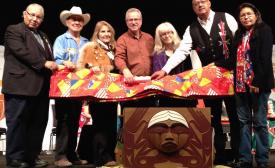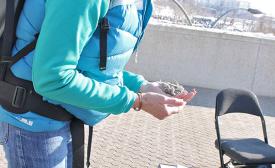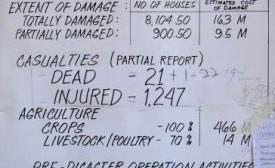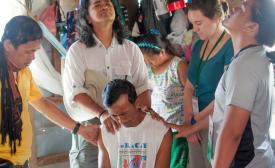Niagara-area thrift store marks 40 years
The Niagara-area Mennonite churches celebrated the 40th anniversary of the thrift stores in this area on March 24 with a dinner and potluck dessert. Over 200 past and present volunteers attended.
The Niagara-area Mennonite churches celebrated the 40th anniversary of the thrift stores in this area on March 24 with a dinner and potluck dessert. Over 200 past and present volunteers attended.

Josephine and Garcie Cogar of Webster Springs, W.V., test out their new walking bridge that connects their home to the community. It was built by Mennonite Disaster Service volunteers as part of the organization’s efforts after Hurricane Sandy devastated the eastern seaboard of the U.S. in 2012. MDS and community volunteers can be seen in the background. (MDS photo by Paul Hunt)
Thirteen metres isn’t a long walk, but it can be a difficult journey when the creek between your house and the rest of your community is running high and the bridge across it is out.
The former St. Mary’s Indian Residential School in Mission drew 50 Fraser Valley Mennonites on May 10 to hear stories of history and culture by the Stó:lō Nation leadership.
Justice Murray Sinclair proudly and lovingly put his arm around Sarah, his granddaughter. “Tomorrow is one of the most important days in my life, the birthday of my granddaughter,” he said of the eight-year-old. “Many of the children taken from families and placed in residential schools were even younger than this. Whenever I do my work, I think about her.
I was standing beside Neill Von Gunten, former co-director of Mennonite Church Canada Native Ministries, and trying to peer over heads to see into the “Churches Listening Area” at the final Truth and Reconciliation Commission (TRC) national event in Edmonton last month. An aboriginal leader had just prayed, and a church leader suggested a song; “We are Marching in the Light of God.”

Anabaptist leaders present a blanket and a statement for inclusion in the Bentwood Box, a repository for offerings and commemorations at the Truth and Reconciliation Commission (TRC) event in Edmonton last month. Standing with the TRC commissioners and survivor representatives are Tim Dyck of the Evangelical Mennonite Conference, centre, and Hilda Hildebrand of Mennonite Church Canada, fifth from left.
The following statement was presented at the final Truth and Reconciliation Commission hearings in Edmonton in March.
Because Jesus asked us to love our neighbours, a group of Christians from Winnipeg were willing to walk 550 kilometres to honour and remember their indigenous brothers and sisters who have survived the Indian Residential School (IRS) system. I was one of the organizers of this journey, which we called the Honour Walk.

Irene Crosland adds some prairie sage to the sacred fire burning outside one of the main entrances to the Shaw Conference Centre in Edmonton, the site of the seventh and final national Truth and Reconciliation Commission (TRC) event. She wrote this poem as a result of her experiences at the TRC event.
Gathering crowd surges
Finding space
Residential School survivors
And listeners
This is my time
You listen
Throbbing drum beats
Pulsing loudly
Tonal language singing
Prayers lifting
Bowed shoulders quake
Remembering robbed childhood
Secrets buried deeply
Opening carefully
Angry man turns
According to Ernie Regehr, for statistical purposes a war is defined as political fighting—not criminal violence—that engages the security forces of the state; as well, it is a situation in which “at least 1,000 people [combatants and civilians] have been killed directly by the fighting during the course of the conflict, and 25 or more are killed annually.”
What do Mennonites and former gang members have in common? “Not much,” one might be tempted to reply. But at a recent Saskatoon conference they sat side-by-side learning about gang intervention and prevention, and the way back to a healthy life.
As Syrians continue to watch their nation disintegrate, Mennonite Central Committee (MCC) has become a leading Canadian responder there. Its long-standing relationships in the area mean it can work both in refugee camps outside Syria and in some of the hardest hit areas within the country, supporting various local partners, including churches.
Without conventional agriculture more people would starve. That is the link commonly drawn between global hunger and the dominant form of North American farming, which depends heavily on fertilizer, fuel, pesticide and genetic inputs.

A damage report from Super Typhoon Haiyan compresses a huge disaster into one page of stark statistics. This report is for just one assessment area. (Photo by John Chau / Used by permission)

Dann Pantoja, second from left, and his team pray for the pastor of a local church. ‘His house was totally destroyed,’ says Pantoja. ‘His wife and children were hungry when we arrived. Many of his neighbours died. He cannot locate the families belonging to his congregation.’ (Photo by Daniel Byron ‘Bee’ Pantoja / From the PBCI website)
Like the news, the winds and rain that came with Super Typhoon Haiyan have let up. But the damage from the storm that slammed regions of the Philippines on Nov. 8, 2013, remains on the mental and emotional front page for survivors.
A week after torrential rain battered the Gaza Strip, people in the al Nafaq Street area of eastern Gaza City were still struggling to clean mud and debris out of their homes and businesses just before Christmas.
Twenty-four-year-old Andy Arthur remembers the April day in 2013 that a factory full of garment workers collapsed in Bangladesh.